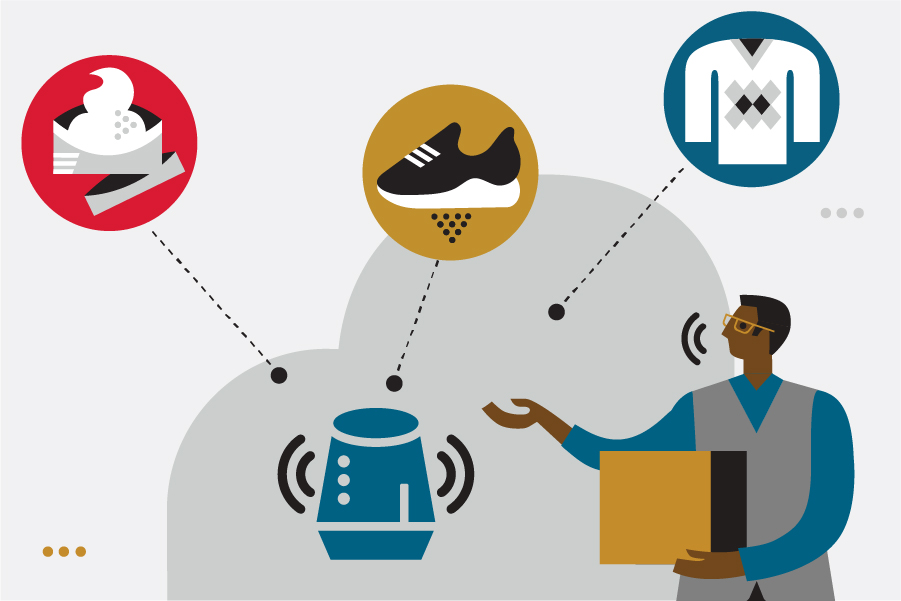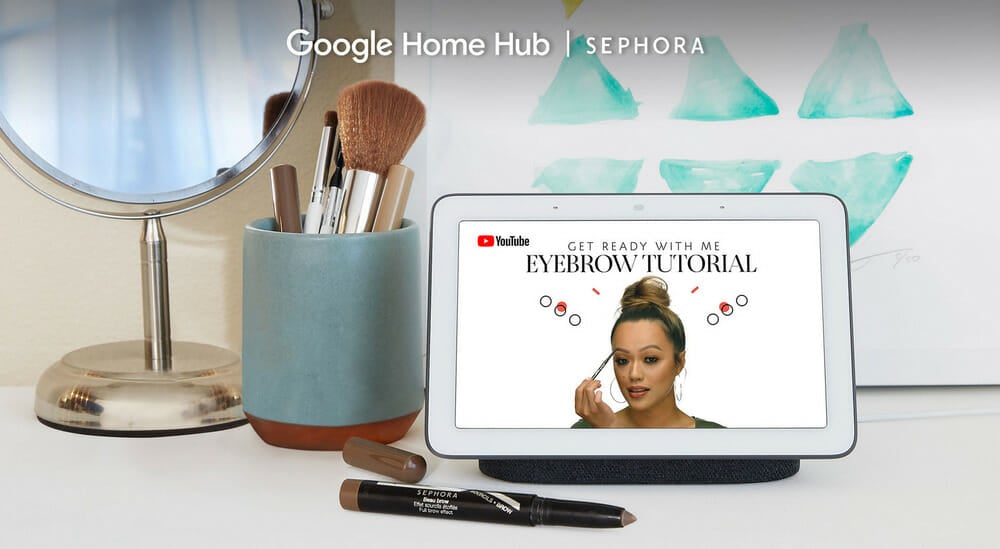Logistics
Industries
Technology & Innovations
E-commerce
E-commerce Fulfillment Services
Lease & Maintenance
Semi Trucks
Logistics
E-commerce
Lease & Maintenance
Buy Used Trucks

"Hey, Siri..."
With the rise of the always-there, in-the-palm-of-your-hand digital assistant, it's not uncommon to hear these words on a crowded city street or in the comfort of your own home.
In fact, 72% of consumers say they've used voice search using digital assistants like Apple's Siri, Amazon's Alexa, and Microsoft's Cortana.
And guess what? They're not just searching - they're purchasing too.
In 2021, over 45 million consumers in the US used voice technology during their online shopping experience, bumping the global value of voice commerce transactions to almost $5 billion dollars.
And these numbers are growing - every day.
Picture this: you've had a long day and have finally put your feet up. Suddenly, you remember - you're out of contacts. Instead of having to make your way to your computer or mobile device, you can simply say: "Alexa, reorder contacts."
Voila! With a simple statement, your contacts are on their way.
This is voice commerce: - using your voice to search for or purchase products online. No more typing on a keyboard or touchscreen - all you need to do is ask your digital voice assistant a question or give it a command.
To understand voice commerce, we'll need to take a few steps back to its foundation: vocal recognition technology.
Voice recognition technology allows a device or program to recognize and decode the human voice. It may sound straightforward, but in reality, it's very complex.
First, voice recognition technology will filter sound into a "readable" format that it can translate. From there, it will use previous inputs and an algorithm to guess what was said, and respond appropriately. Like many artificial intelligence programs, it improves with continued use.
Essentially, voice recognition makes it possible for our smartphones and smart speakers to understand spoken commands, questions, and more.
As a consumer, all you need is your voice, right? Not exactly. There's a great deal that goes into voice commerce for it to be a frictionless experience.
You'll need a device that has a voice assistant and the ability to understand certain commands, like a smartphone or a smart speaker. You also need to go through the trial era of allowing your voice assistant to "learn" how you like to interact.
Plus, if you're planning on making a purchase rather than just searching, your payment information needs to be stored in your device via a digital wallet for quick buying.
Once you have everything in place, voice commerce is effortless. All you need to do is speak an activation phrase that will get your digital voice assistant to perk up (Okay Google!), and clearly state you're intention.
"Okay Google - what's the best-reviewed yoga mat?"
"Hey Alexa - what's the highest-reviewed women's running shoe on Amazon?"
The great thing about voice commerce shopping is the seemingly endless number of paths you can take. Consumers don't have to have a specific product in mind and use voice commands to purchase immediately. Instead, they can engage in a sort of conversation with their voice assistants to explore different products, services, and reviews.
While voice commerce is relatively new to the e-commerce space, it's growing rapidly. The total value of voice-activated shopping is expected to rise from around $5 billion dollars in 2021 to a whopping $19.4 billion dollars in 2023. This is more than 400% growth in just two years.
If you're not already looking into voice ordering opportunities for your e-commerce store, it's high time to start. Plus, early adopters always have the competitive advantage of trial and error before the rush, meaning their technology is ready to go as their consumers are.
By today's digital standards, if you're not ahead of the game - you're behind. New technologies seem to pop up every day, always with a stronger customer experience at the forefront. Consumers want seamless, secure, and personalized shopping. Voice technology offers all of the above, and it's gaining popularity for good reason.
Speaking is the most natural form of communicating, and it's inherently quicker than any other. Have you ever had something to say that's too long to type out for an email or text? The go-to alternative? A phone call or meeting.
It only makes sense that customers are beginning to rely more and more on digital voice assistants for communication; it provides a universe where they won't have to pause whatever it is they're doing to complete another task.
Allowing customers to use a voice command and a virtual assistant to search for or purchase products on your site promises smoother, and smarter buying journeys, which is exactly what they're looking for.
Did you know that 80% of customers are more likely to purchase from brands that provide personalized experiences? With that high of a percentage, there's really no getting away from the positive impact and ROI that personalization can have!
Incorporating voice commerce into your e-commerce store immediately presents a more personalized approach to online shopping. How? Voice assistants are programmed to become more personal, to "know" who they're talking to. With the ability to save order histories and past requests, reordering is easy, and recommendations are quickly available.
Plus, if there are any special requests and filters, like dietary restrictions or allergies, voice assistants can take note. The result? A more tailored shopping experience, with much less typing, swiping, and clicking.
Voice commerce can quickly expand your brand's reach, simply because there are already many consumers dabbling in digital assistants and voice shopping. Narvar's research found that 51% of consumers are using voice search to research products, while 22% make purchases with a voice command.
Accessible from virtually any device, the most popular method of voice commerce is Google's voice search feature.

What does this mean for e-commerce brands? If your products are listed within Google Shopping, they'll be accessible to any consumers using voice shopping (as long as you're able to integrate your catalog with Google Merchant Center).
Replenishment is one of the most common and efficient ways for e-commerce brands to implement voice commerce. Why? The order is already there.
Once you've purchased your product for the first time, all that's needed to reorder are voice commands. Remember "Alexa, reorder contacts"? The reply might be something like "Okay - it will be $125 for 3 months worth of contacts. Confirm purchase?"
Without any typing, searching, or stopping - a simple "yes" will get your product moving.
If consumers are already using digital assistants to research and buy products, or simply just online shopping via mobile devices, a history of their search and purchasing behavior is available for voice technology to pull from.
Because artificial intelligence is continuously improving and "learning," virtual assistants can begin to understand their consumers' preferences like dietary restrictions, past purchases, and more to make relevant product recommendations during a voice search.
If you've ever ordered something online, you know how important that tracking link is! And now, there's an even easier way of staying in the know about your deliveries. You guessed it - voice commerce.
Voice-based delivery notifications and tracking abilities can take your customer experience to an entirely new level.
"Alexa, where's my order?"
"Your order is out for delivery and expected to arrive by 9pm."
If only everything in life was as easy as that!
The novelty of voice commerce technology, and the fact there's still a lot to learn when it comes to successful implementation, is causing hesitation among many banks and credit card companies.
Mobile payment platforms like Venmo and PayPal are allowing their customers to use voice commands to carry out functions. On the other hand, traditional banks in the financial sector haven't been as quick to add conversational commerce into the mix.
While voice commerce is becoming more popular, it's clear there are concerns around the overall reliability and safety of purchasing products with voice commands.
More than half of consumers said they would rather use voice commerce technology for goods and services that aren't of high value, and almost two-thirds like to see a greater choice of verification methods when securing online payments.
Because it is inherently "easy," voice commerce can be considered a less secure method of payment. Passwords or verification methods aren't regularly used with a smart speaker, making the possibility of fraud higher - even if it is just your kids ordering too many Legos!
Conversational AI is still an emerging area. This means there's a lot we don't know about it just yet. It's not uncommon for voice assistant users to feel like their interactions are limited, "not human," or intuitive.
Plus, consumers who lack information regarding the capabilities of voice assistants are more likely to become skeptical of the technology and deem it too risky altogether.
"Alexa, what are my deals today?"
With Amazon's Alexa, customers can create shopping lists and purchase products directly with simple voice commands. Plus, Alexa helps to suggest products that their customers have frequently purchased and draws on buying behavior to find the most relevant products. Over time, Alexa will learn your preferences and create amore intuitive shopping experience.
"Hey Google, show me foundation tips videos from Sephora."
Sephora partnered with Google in 2018 to bring consumers beauty-specific commands relating to their incredibly popular YouTube channel. With a quick voice search, Sephora audiences can access a channel of more than 2k tutorial content to choose from.

Image Credit: Google
"Okay Google talk to Walmart."
In 2019, Walmart rolled out its partnership with Google Assistant, giving their customers the ability to add items directly to their Walmart grocery cart (with the help of their history of previous purchases).
"In addition to helping our busy families with this simple solution, a key benefit of this new service is that it’s personalized just for them. By understanding our customers’ preferences, we also solve the paradox of choice and save them time by serving up what we know they love best."
"Alexa, open Johnnie Walker."
Johnnie Walker partnered with Amazon's Alexa to help make their whiskey accessible, less intimidating, and more personally relevant to their customers. After launching with the command statement above (and confirming their age is above 21), consumers can choose from 4 different options: Choose a Label, Buy a Bottle, Whiskey 101, or Try a Guided Tasting.
Choosing a Label launches a series of questions around the consumer's flavor preferences and budget to determine whiskey and cocktail recommendations while Whiskey 101 prompts Alexa to share a random fact for some clever happy hour conversations.

Whether it's a compatible smart device in hand, a Google assistant on call, or a smart speaker in multiple rooms of the house, your customers are looking for the same things - speed, convenience, and personalization.
Voice commerce takes all three, melding it into a personalized, interactive shopping experience. The results? Happier customers, a greater ROI, and a massive opportunity to add even more value to the buying journey.